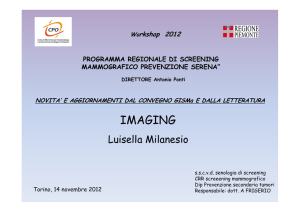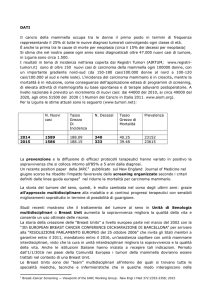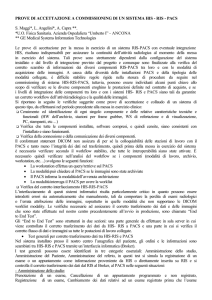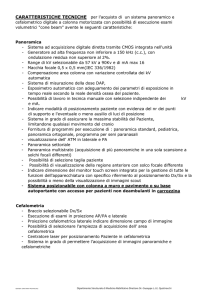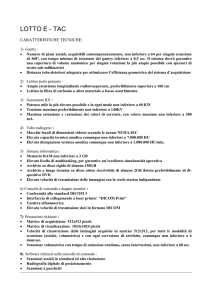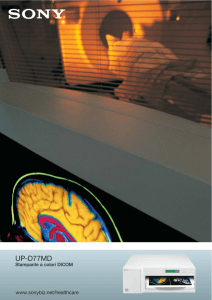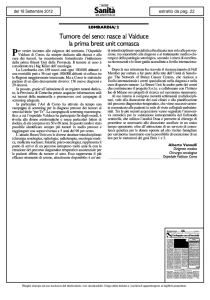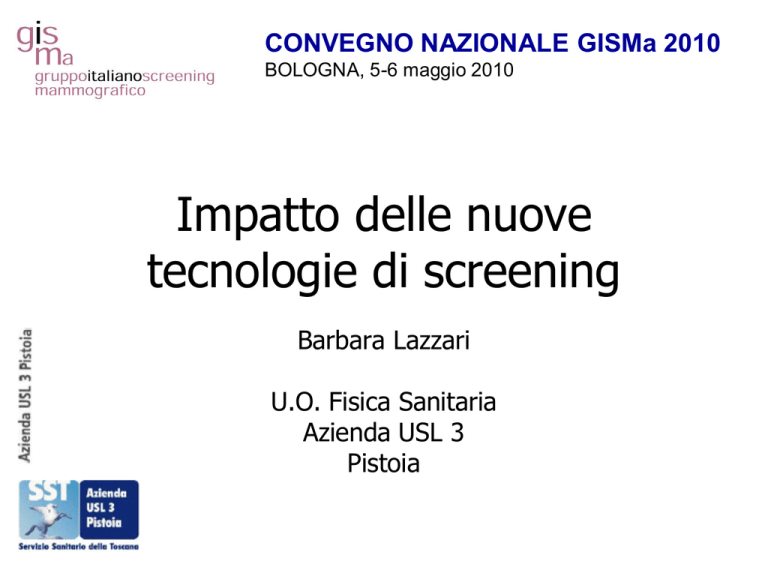
CONVEGNO NAZIONALE GISMa 2010
BOLOGNA, 5-6 maggio 2010
Impatto delle nuove
tecnologie di screening
Barbara Lazzari
U.O. Fisica Sanitaria
Azienda USL 3
Pistoia
Impatto delle nuove tecnologie di
screening
• Nuove tecnologie per l’acquisizione delle
informazioni
• Nuove tecnologie per la gestione delle
informazioni
Nuove tecnologie per l’acquisizione delle
informazioni
Mammografia convenzionale (DM):
Rappresentazione 2D di un oggetto 3D.
La rappresentazione 3D della mammella viene generata nel
cervello del radiologo da due proiezioni bidimensionali
tipicamente CC e OBL
Sovrapposizione di strutture anatomiche che generano
rumore strutturato sulle immagini
Poche proiezioni bidimensionali per dedurre la
corrispondente realtà tridimensionale
Contrast-enhanced digital mammography
• Dual Energy Subtraction Digital Mammography
(DEDM)
– Doppia esposizione con mezzo di contrasto
– Singola scansione con ESS (electronic spectrum
splitting) con mezzo di contrasto
– Singola scansione con ESS (electronic spectrum
splitting) senza mezzo di contrasto
• Temporal subtraction
Dual Energy Digital Mammography
• Si sfrutta il fatto che i diversi tessuti presenti nella
mammella presentano una diversa dipendenza dall’energia
del fascio
• Scegliendo opportunamente le due energie, è possibile in
pratica “cancellare” il fondo ed enfatizzare il contrasto
delle strutture patologiche.
• Doppia esposizione con mezzo
di contrasto: si inietta un
mezzo di contrasto iodato e si
acquisiscono due diverse
immagini ad “alta” e “bassa”
energia dopodichè si effettuata
la sottrazione delle immagini.
I S ln(nhigh) w ln(nlow )
25 kV
DUAL ENERGY
49 kV
IMMAGINE
SOTTRATTA
Courtesy of Mauro Gambaccini
Dual Energy Digital Mammography
Convenzionale
Lewin et al, Radiology 229, 261-268, 2003
Dual-energy
Dual Energy Digital Mammography
Single scan ESS
Misurando l’altezza dell’impulso in un single photon counter è
possibile stimare l’energia del singolo fotone (colore) e
mediante una elettronica opportuna, simulare una doppia
energia applicando una soglia.
• ASIC (application specific integrated
circuit) with dual threshold
• Anti coincidence logic (energy)
• No low and high energy spectra overlap
• Single scan
Dual Energy Digital Mammography
Single scan ESS – Contrast medium
Low
Low energy
energy image
image
High energy
energy image
High
image
All Total
energy
image
image
Dual
energy
image
Dual
energy
subtraction
Bornefalk H, Lewin JM, Danielsson M, Lundqvist M. Single-shot dual-energy subtraction
mammography with electronic spectrum splitting: Feasibility. Eur J Radiol 2006;60:275-278
Temporal Subtraction
Jong, R. A. et al. Radiology 2003;228:842-850
Dual Energy Digital Mammography
Single scan ESS – No contrast medium
Subtraction using anthropomorphic phantom
Subtraction using anthropomorphic phantom
Experiment with Specimen
Doc. No/Page 13(xx)
2007-xx-xx/Signature
ROI setup
Doc. No/Page 14(xx)
2007-xx-xx/Signature
Cancellation of cyst
Doc. No/Page 15(xx)
2007-xx-xx/Signature
Tecniche 3D
•
•
•
•
Breast Tomosynthesis (BT)
Dual Energy Breast Tomosynthesis (DEBT)
CT Breast Imaging (CTBI)
Positron Emission Mammography
Breast Tomosynthesis (BT)
• Vengono acquisite una serie di proiezioni bidimensionali
a bassa dose per diverse angolazioni del tubo rx intorno
alla mammella con detettore fermo rispetto all’organo in
esame.
• I dati acquisiti vengono ricostruiti in una serie di strati
sottili ad alta risoluzione.
Vincoli
• Dose totale all’organo accettabile (~ dose per MX doppia
proiezione).
• Qualità dell’immagine ricostruita adeguata
• Tempo di scansione contenuto (artefatti da movimento).
Breast Tomosynthesis (BT)
• Sistema anisotropo
– Angolo totale di scansione
ridotto
– Scansione angolare non
uniforme
– Diminuzione della risoluzione
spaziale del rivelatore
all’aumentare dell’angolo di
scansione mediante “pixels
binning”
– Riduzione della
dose/proiezione per angoli
elevati
Images from Sectra prototype
Film-screen
mammography
Work in
progress
3D photon
counting
Breast CT
Breast CT
A computer simulation study comparing lesion detection accuracy with
digital mammography, breast tomosynthesis, and cone-beam CT breast
imaging.
Gong X, Glick SJ, Liu B, Vedula AA, Tracker S
Med Phys. 2006 Apr;33(4):1041-52
Although conventional mammography is currently the best modality to detect early breast cancer, it is limited in that the
recorded image represents the superposition of a three-dimensional (3D) object onto a 2D plane. Recently, two promising
approaches for 3D volumetric breast imaging have been proposed,
breast imaging (CTBI).
breast tomosynthesis (BT) and CT
To investigate possible improvements in lesion detection accuracy with either breast
tomosynthesis or CT breast imaging as compared to digital mammography (DM), a computer simulation study
was conducted using simulated lesions embedded into a structured 3D breast model. The computer simulation realistically
modeled x-ray transport through a breast model, as well as the signal and noise propagation through a CsI based flat-panel
imager. Polyenergetic x-ray spectra of Mo/Mo 28 kVp for digital mammography, Mo/Rh 28 kVp for BT, and W/Ce 50 kVp for CTBI
were modeled. For the CTBI simulation, the intensity of the x-ray spectra for each projection view was determined so as to
provide a total average glandular dose of 4 mGy, which is approximately equivalent to that given in conventional two-view
screening mammography. The same total dose was modeled for both the DM and BT simulations. Irregular lesions were
simulated by using a stochastic growth algorithm providing lesions with an effective diameter of 5 mm. Breast tissue was
simulated by generating an ensemble of backgrounds with a power law spectrum, with the composition of 50% fibroglandular
and 50% adipose tissue. To evaluate lesion detection accuracy, a receiver operating characteristic (ROC) study was performed
with five observers reading an ensemble of images for each case. The average area under the ROC curves (Az) was 0.76 for
Results indicated that for the same dose, a 5 mm lesion
embedded in a structured breast phantom was detected by the two volumetric
breast imaging systems, BT and CTBI, with statistically significant higher
confidence than with planar digital mammography, while the difference in lesion
detection between BT and CTBI was not statistically significant.
DM, 0.93 for BT, and 0.94 for CTBI.
Microcalcification detection using cone-beam CT
mammography with a flat-panel imager
Xing Gong et al 2004 Phys. Med. Biol. 49 2183-2195
Xing Gong, Aruna A Vedula and Stephen J Glick
Department of Radiology, University of Massachusetts, Medical School, Worcester, MA 01655,
US
Abstract. The purpose of this study was to investigate microcalcification detectability using
CT mammography with a flat-panel imager. To achieve this, a computer
simulation was developed to model an amorphous-silicon, CsI based flat-panel imager
system using a linear cascaded model. The breast was modelled as a hemi-ellipsoid shape
with composition of 50% adipose and 50% glandular tissue. Microcalcifications were modelled
as small spheres having a composition of calcium carbonate. The results show that with a
mean glandular dose equivalent to that typically used in two-view screening mammography,
CT mammography with a flat-panel detector is capable of providing images where most
microcalcifications are detectable. A receiver operating characteristic (ROC) study was
conducted by five physicist observers viewing simulated CT mammography reconstructions.
The results suggest that the microcalcification with its diameter equal to
or greater than 0.175 mm can be detected with an average area under
the ROC curve (AUC) greater than 0.95 using 0.1 or 0.2 mm pixelized
detectors. The results also indicate that the optimal pixel size of the detector is around 0.2
mm for microcalcification detection, based on the trade-off between detectability of
microcalcifications and the time required for data acquisition and reconstruction.
Positron Emission Mammography
(PEM)
PEM Flex
X-Ray
PEM Flex™
Whole Body PET
X-Ray CT
Invasive ductal
carcinoma
with central
necrosis
Pem
Flex
X-ray
Multifocal cancer
X-ray
Occult DCIS in
a single duct
• 10mCi FDG
• Acquisizione un’ora dopo somministrazione per una durata di circa 10
minuti
• 1000 cristalli di lutezio per ciascun detettore
• 2 detettori su due compressori (MLO e CC)
• 1,5 mm di risoluzione spaziale
Positron Emission Mammography
(PEM)
Phys Med Biol. 2008 Feb 7;53(3):637-53. Epub 2008 Jan 10
The positron emission mammography/tomography breast imaging and
biopsy system (PEM/PET): design, construction and phantom-based
measurements.
Raylman RR, Majewski S, Smith MF, Proffitt J, Hammond W, Srinivasan A, McKisson J, Popov V,
Weisenberger A, Judy CO, Kross B, Ramasubramanian S, Banta LE, Kinahan PE, Champley K.
Center for Advanced Imaging, Department of Radiology, West Virginia University, Morgantown, WV, USA.
[email protected]
[..]. We have developed a high-resolution positron emission mammography/tomography imaging
and biopsy device (called PEM/PET) to detect and guide the biopsy of suspicious breast lesions.
[..] The PEM/PET scanner consists of two sets of rotating planar detector heads. Each detector
consists of a 4 x 3 array of Hamamatsu H8500 flat panel position sensitive photomultipliers
(PSPMTs) coupled to a 96 x 72 array of 2 x 2 x 15 mm(3) LYSO detector elements (pitch = 2.1
mm). Image reconstruction is performed with a three-dimensional, ordered set expectation
maximization (OSEM) algorithm parallelized to run on a multi-processor computer system. The
reconstructed field of view (FOV) is 15 x 15 x 15 cm(3). Initial phantom-based testing of the
device is focusing upon its PET imaging capabilities. [..] These promising findings indicate that
PEM/PET may be an effective system for the detection and diagnosis of breast cancer.
Nuove tecnologie per la gestione delle
informazioni
•
•
•
HIS: Hospital Information System (SIO: Sistema
Informativo Ospedaliero)
RIS: Radiological Information System
PACS: Picture Archive and Communication System
RIS/PACS
Nuove tecnologie per la gestione delle
informazioni
•
Informazioni digitali (dati & immagini)
–
–
–
–
•
Generate: modalità digitali
Trasferite: connettività
Analizzate: refertazione soft-copy, statistiche, ecc..
Conservate: archiviazione e conservazione legale
Flusso di lavoro “digitale”
–
–
–
•
Analisi dei processi: cosa deve andare dove e per chi
Reingegnerizzazione dei processi: cosa sarebbe meglio che andasse dove e
per chi
Politiche di sicurezza: conservazione legale, firma digitale, privacy, ecc..
Reti di trasmissione
–
–
•
Cosa voglio dove e in quanto tempo
Politiche di sicurezza
Formazione
–
Specifica con contenuti mirati alle nuove tecnologie
“Chi” ci aiuta..
Standard
DICOM: Digital Imaging Communication in Medicine
• È un tool di interfaccia/integrazione
• non riguarda né le caratteristiche del rivelatore né la qualità
delle immagini acquisite
•
Tutte le apparecchiature che producono o gestiscono immagini devono
rispettare lo standard DICOM per la modalità richiesta, in particolare
DICOM MG per la mammografia, anche per sistemi CR.
•
Al fine della corretta gestione delle immagini e dell’integrazione con il
RIS devono anche supportare altre classi di servizi Dicom (ad es.
DICOM modality worklist, DICOM modality performed procedure step,
DICOM storage, DICOM query/retrieve, DICOM print, ecc..
Dicom Conformance Statement
“Chi” ci aiuta..
Iniziative
IHE: Integrating Healthcare Enterprises
• È un processo per raggiungere l’interoperabilità tra sistemi
basata sull’adozione di standard
• non è uno standard
• Vengono identificati dei profili di integrazione con funzionalità
specifiche (ad. es Mammo, Nuclear Medicine, CT, ecc..)
“Chi” ci aiuta..
IHE: Radiology profile
• Scheduled workflow (SWF): definisce l’integrazione tra scheduling,
image acquisition, storage e viewing per immagini radiologiche
• Patient Information Reconciliation (PIR): coordina il
riallineamento dei dati relativi ad un paziente quando le immagini sono
state acquisite “anonime”
• Mammography Image (Mammo): specifica come devono essere
generate, scambiate, usate e visualizzate le immagini mammografiche
• Consistent Presentation of Images (CPI): permette una
visualizzazione consistente su diversi sistemi di visualizzazione sia softche hard-copy
Perché IHE se c’è DICOM?
Dicom
Dicom+IHE
Hanging protocols
Dicom+IHE
Dicom
(RIS/PACS) Workstation per refertazione
•
Sono ormai disponibili molte WS integrate
(RIS/PACS) dedicate alla refertazione soft-copy delle
imagini mammografiche, con monitor ad alta
risoluzione (5MP) e sistemi integrati per il controllo di
qualità.
•
Non sempre gli applicativi delle WS sono in grado di
gestire completamente il flusso di lavoro per lo
screening, mentre normalmente supportano l’attività
clinica.
•
Spesso sulle WS di corredo al mammografo digitale
vengono applicati degli algoritmi di visualizzazione
che non è possibile riprodurre sulle WS RIS-PACS
(RIS/PACS) Archivi
• Niente di diverso rispetto all’archiviazione di immagini
provenienti da diverse modalità.
• Attenzione a valutare correttamente lo spazio necessario (solo
immagini “for presentation” o anche “for processing”? Quanto
on-line e quanto near-line, back-up e disaster recovery…)
• Devono essere ridondanti
(RIS/PACS)
• Attenzione all’integrazione del RIS con il PACS!!
– I due sistemi possono anche essere di due fornitori diversi,
ma deve essere garantita la funzionalità complessiva.
– Una non corretta integrazione tra i due potrebbe comportare
scambio di dati ed immagini tra pazienti diversi.
– Gestione del rischio clinico.
Nuove tecnologie per la gestione delle
informazioni
• Gli attuali sistemi RIS/PACS gestiscono, nella quasi totalità, il flusso
informativo (dati ed immagini) relativi al flusso di lavoro per
l’attività clinica ambulatoriale.
• I programmi di screening mammografico vengono attualmente
gestiti da applicativi dedicati, ad elevata specializzazione e scarsa
integrazione con sistemi RIS/PACS
• E’ necessaria una attività importante di integrazione con i sw
utilizzati localmente per la gestione dello screening.
profilo IHE - REM
Radiation Exposure Monitoring (REM) Integration Profile
Trial Implementation Draft
Publication date: July 3, 2008
RX (DR), mammo (MG), fluoro e CT: invio indici
dosimetrici tramite oggetto Report Strutturato
Dosimetrico (SR): gli oggetti Dicom SR sono trasmessi in
rete e memorizzabili in sistemi PACS.
Il documento strutturato può essere costruito a partire dai template previsti
per le tecniche proiettive e tomografiche:
TID 10001 Projection X-ray Radiation Dose (TID 10005 Accumulated
Mammography X-ray Dose);
TID 10011 CT Radiation Dose.
Report Strutturato (SR – Radiation Dose)
Grazie dell’attenzione
Barbara Lazzari
[email protected]

